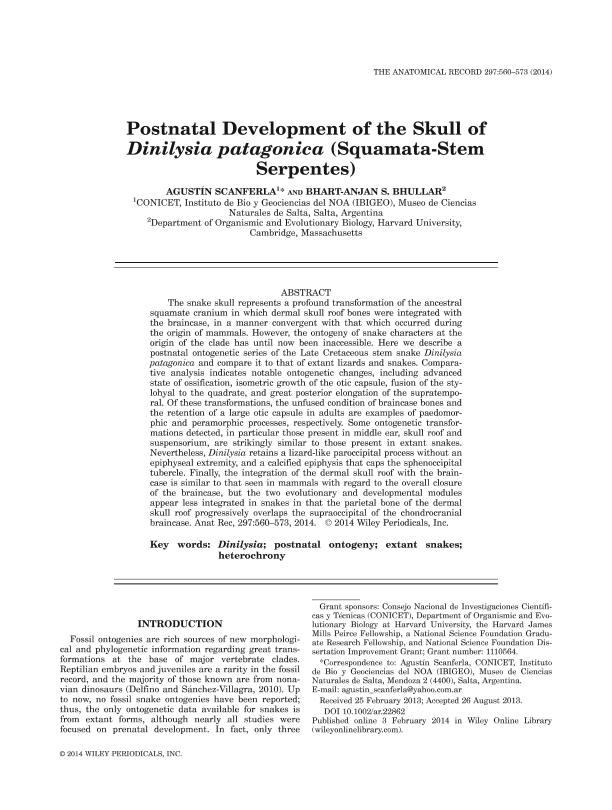Artículo
Postnatal development of the skull of Dinilysia patagonica (Squamata-stem Serpentes)
Fecha de publicación:
01/2014
Editorial:
Wiley
Revista:
Anatomical Record
ISSN:
1932-8486
Idioma:
Inglés
Tipo de recurso:
Artículo publicado
Clasificación temática:
Resumen
The snake skull represents a profound transformation of the ancestral squamate cranium in which dermal skull roof bones were integrated with the braincase, in a manner convergent with that which occurred during the origin of mammals. However, the ontogeny of snake characters at the origin of the clade has until now been inaccessible. Here we describe a postnatal ontogenetic series of the Late Cretaceous stem snake Dinilysia patagonica and compare it to that of extant lizards and snakes. Comparative analysis indicates notable ontogenetic changes, including advanced state of ossification, isometric growth of the otic capsule, fusion of the stylohyal to the quadrate, and great posterior elongation of the supratemporal. Of these transformations, the unfused condition of braincase bones and the retention of a large otic capsule in adults are examples of paedomorphic and peramorphic processes, respectively. Some ontogenetic transformations detected, in particular those present in middle ear, skull roof and suspensorium, are strikingly similar to those present in extant snakes. Nevertheless, Dinilysia retains a lizard-like paroccipital process without an epiphyseal extremity, and a calcified epiphysis that caps the sphenoccipital tubercle. Finally, the integration of the dermal skull roof with the braincase is similar to that seen in mammals with regard to the overall closure of the braincase, but the two evolutionary and developmental modules appear less integrated in snakes in that the parietal bone of the dermal skull roof progressively overlaps the supraoccipital of the chondrocranial braincase.
Palabras clave:
Dinilysia
,
Skull
,
Ontogeny
,
Heterochrony
Archivos asociados
Licencia
Identificadores
Colecciones
Articulos(IBIGEO)
Articulos de INST.DE BIO Y GEOCIENCIAS DEL NOA
Articulos de INST.DE BIO Y GEOCIENCIAS DEL NOA
Citación
Scanferla, Carlos Agustín; Bhullar, Bhart Anjan; Postnatal development of the skull of Dinilysia patagonica (Squamata-stem Serpentes); Wiley; Anatomical Record; 297; 3; 1-2014; 560-573
Compartir
Altmétricas




